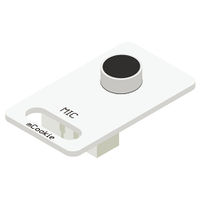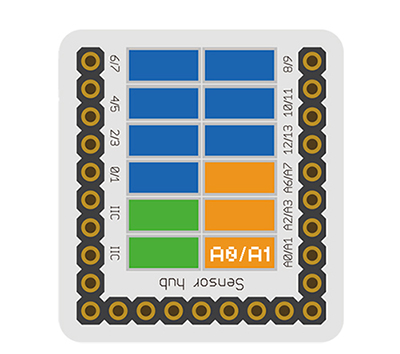|
The product number of Sensor-MIC is: MSDT11
Sensor-MIC is sound detection sensor module.
Electret microphone is composed of sound electric conversion and impedance conversion. The key component of sound electric conversion is electret diaphragm, which is a slice of thin plastic film of which one side is steamed with a layer of metal film, and after the electret by high voltage field, the two sides respectively has opposite charges, the steamed gold face of the diaphragm is outward, and is connected with the metal case. In the electret microphone, there is a field effect tube to do pre amplifier, so a certain blas voltage is needed when the electret microphone is working normally, which is generally not greater than 10v.
Instruction of Sensor Pin
Microphone Sensor
| General Pin Out
|
Sensor / Trinket's Pin Out
|
| PIN1 (GND)
|
GND
|
| PIN2 (VCC)
|
VCC
|
| PIN3 (SIGNAL-A)
|
Analog Input
|
| PIN4 (SIGNAL-B)
|
Not Connected
|
- General Pin Out is the standard pin out of a Sensor / Trinket connector.
- Sensor / Trinket's Pin Out is this specific Sensor / Trinket's wiring in relation to the General Pin Out.
- SIGNAL-A / SIGNAL-B are signals that could be digital input, digital output, analog input or analog output. Or special signals such as serial communication (SoftwareSerial, IIC (I2C), etc) or other special signals.
- Not Connected refers to the Pin not being used for this particular Sensor / Trinket.
- Read more about the hub module.
Features
- Capacitive sound detection component
- Low power and high sensitivity
- With small size which is easy to install
Specification
- Size
- Size of the board: 23.5mm*13mm
- 1.27mm-spacing 4Pin interface connected to sensorhub
- The CAD drawing of the sensor: File:Sensor CAD.zip
- Technical parameters
- Measuring voltage: 0~5V(measuring frequency range 100Hz~4000Hz)
- Measuring sound intensity: 45~120dB
- Accuracy: ±1%
- Connection
- This sensor can be connected to the following interfaces of core: A0~A7
Document
Development
Program Download
Programming
Hardware Setup
- Referring to the following diagram, connect the Sensor-MIC to the analog interface A0/A1 of Microduino-Sensorhub
Result
- After download, open the serial monitor.
- The value displayed in the serial monitor reflects the current sound intensity detected by the MIC sensor.
Application
It can be used to collect sound or detect the sound shaking.
Project
Purchase
History
Gallery
|


